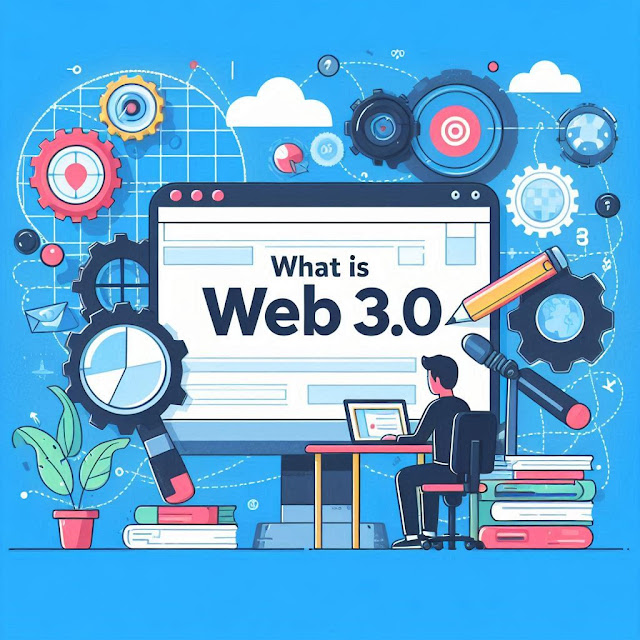What is Web 3.0? A Deep Dive into the Future of the Internet
The internet is evolving—and we're standing at the brink of its next major leap: Web 3.0. If Web 1.0 was about reading static content, and Web 2.0 brought interaction and social networking, Web 3.0 is about decentralization, intelligence, and true user ownership.
But what exactly is Web 3.0? Why is everyone—from developers to digital marketers—talking about it? Let’s unpack the fundamentals, explore its features, and understand how it’s shaping the future of the digital world.
🌐 The Evolution: Web 1.0 → Web 2.0 → Web 3.0
To understand Web 3.0, it’s essential to look back at its predecessors.
-
Web 1.0 (early 1990s–early 2000s) was static. Think of it as a digital brochure—read-only pages with minimal interactivity.
-
Web 2.0 brought user-generated content, social media, and cloud computing. This is the web we mostly use today—interactive but controlled by centralized entities like Google, Meta, and Amazon.
-
Web 3.0 changes the game by putting power back in the hands of users through decentralized technologies, smart contracts, AI, and blockchain .
Want a full overview of how we transitioned from Web 1.0 to Web 3.0? Check out our blog on the Evolution of the Web.
🚀 What is Web 3.0?
Web 3.0 is often described as the “semantic web” or the “decentralized web.” At its core, it's built on the principles of:
-
Decentralization – No single entity owns or controls the data.
-
Trustless & Permissionless – Users can interact without intermediaries.
-
AI-Powered – Web 3.0 is more intelligent, using AI and ML to offer more personalized experiences.
-
Data Ownership – Users control their own data and can choose how it's shared or monetized.
-
Interoperability – Applications can connect seamlessly across platforms.
For a breakdown of these traits, see our full post on the Key Features of Web 3.0.
🛠️ How Does It Work?
Web 3.0 runs on technologies such as:
-
Blockchain: The backbone of decentralization.
-
Smart Contracts: Self-executing agreements coded on the blockchain.
-
dApps (Decentralized Applications): Applications that run on peer-to-peer networks instead of centralized servers.
-
Cryptographic Tokens: Used for authentication, governance, and monetization.
To understand the tech stack, especially blockchain, visit our detailed article: Understanding Blockchain Technology.
🔑 Key Benefits of Web 3.0
Let’s dive into the advantages of this new paradigm.
1. Ownership and Control
Unlike Web 2.0 where platforms own your content and data, Web 3.0 enables self-sovereign identity. You own your data, and access is granted via decentralized IDs and wallets.
2. Enhanced Security and Privacy
With blockchain encryption, there's no central point of failure, which makes it harder for hackers to breach data. Plus, privacy is embedded through zero-knowledge proofs and decentralized protocols.
3. Monetization of Digital Assets
NFTs, tokens, and other Web 3.0 assets empower users to monetize content, skills, or even virtual real estate. Explore how NFTs function by reading our guide: What are NFTs?.
4. Censorship Resistance
In a decentralized environment, content isn’t controlled by corporations or governments. Users enjoy freedom of expression like never before.
5. Interoperability Across Platforms
Web 3.0 enables fluid interaction between apps without being locked into one ecosystem. Think logging in once with your crypto wallet and accessing all your favorite platforms seamlessly.
🧠 AI and Web 3.0: A Powerful Combo
Artificial intelligence plays a pivotal role in Web 3.0. From natural language processing (NLP) to semantic search, AI improves how users interact with digital environments.
Want to know how AI enhances this decentralized web? Read our piece on the Role of AI in Web 3.0.
🤔 Web 2.0 vs Web 3.0: What’s the Real Difference?
Here’s a quick comparison:
| Feature | Web 2.0 | Web 3.0 |
|---|---|---|
| Ownership | Platform-controlled | User-owned |
| Monetization | Through ads | Through tokens and NFTs |
| Control | Centralized corporations | Decentralized communities |
| User Identity | Username/password | Crypto wallets, decentralized IDs |
| Data Handling | Stored on servers | Stored on blockchain |
| Content Discovery | SEO, platform algorithms | AI-powered semantic engines |
Want to dive deeper? Visit Web 3.0 vs Web 2.0: A Comparative Analysis.
💼 Why Web 3.0 Matters for the Future of Work & Digital Economy
Web 3.0 isn’t just tech—it’s a shift in power. As creators, professionals, and businesses embrace the decentralized model, new career paths and economies are emerging:
-
Developers creating decentralized apps (dApps)
-
Artists minting and selling NFTs
-
Marketers leveraging token-based loyalty programs
-
Startups launching via DAOs instead of traditional funding
Soon, your resume might include contributions to a DAO or NFTs you’ve created. This is the creator economy redefined.
⚙️ Challenges and Criticisms of Web 3.0
No revolution comes without roadblocks. Web 3.0 faces:
-
Scalability issues
-
Complex user onboarding
-
Unregulated financial risks
-
Energy consumption of blockchain networks
But as technology matures, many of these issues are being actively solved. Want to know more? We'll cover these challenges in our future blog: Risks and Challenges in Web 3.0 .
📚 What to Read Next
If you're just getting started, here are a few suggested reads that will expand your understanding:
These interconnected blogs are part of our comprehensive Web 3.0 Blog Series, designed to help you master this emerging space step-by-step.
🔚 Final Thoughts
Web 3.0 isn’t a buzzword—it’s a new era of the internet that’s already reshaping digital life. Whether you're a developer, entrepreneur, or curious learner, now is the time to start exploring this decentralized universe.
Stay tuned to blog.weskill.org for more deep dives, tutorials, and real-world use cases of Web 3.0. Let’s build the future—together.



Comments
Post a Comment